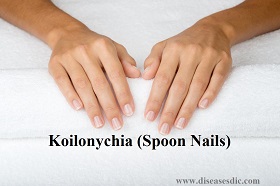Definition
Koilonychia is a condition where the nails do not develop normally and are very thin and concaved with raised edges. Due to the concavity of the nails, they are also known as “spoon” nails. Other than the concavity, koilonychia also affects the texture, color, shape, and thickness of the nails. Koilonychia can affect both fingernails as well as toenails. Koilonychia is quite a common nail abnormality where the nail plate that normally has a convex contour becomes concave in the center with upturned or raised lateral and distal margins. In Koilonychia, nails also become very brittle and thin. The affected nails in koilonychia take a long time to get back to their normal appearance. Koilonychia or Spoon Nails.
Koilonychia (Spoon’s nails)
Risk factors of Koilonychia
- People who are older or have poor blood flow to their fingers and toes may have thinner nails, which may increase their risk of developing koilonychia.
- People who have a higher risk of iron deficiency, such as menstruating women and vegetarians, may be at greater risk for developing koilonychia.
Causes
These are few of the primary causes of spoon nails:
- Improper thyroid hormone
- Iron deficiency
- Using footwear that does not fit well
- Psoriasis
- Infections caused by fungus/bacteria
- Patella syndrome
- The habit of biting nails
- Faulty dietary habits
- Injury at nail matrix
- Heredity
Symptoms of Koilonychia
- The nails take a spoon shape which appears like projecting outwards from the edges and becoming thinner in the center.
- The color and shape of the nails change with this disease. The nails become concave in shape and the nail plates become thin. The outer part of the nails can also get detached.
- There can be pain and swell in case of trauma to the nail and the nail can also come out from the nail bed.
- The color of the bottom surface of the nail can change in secondary infections.
- In case the cause of the disease is iron deficiency, the person may look tired which will depict signs of anemia.
- The surface of the nails plates will appear to be very dry. This will give rise to an extraction of nail easily.
Koilonychia in different age groups
- Koilonychia can have different meanings based on the age of the person with the condition.
- In adults, koilonychia may be a sign of a serious health condition.
- Koilonychia occurs commonly in infants, especially on their big toes, since their nails are fragile. It usually goes away on its own but may take a couple of years. However, koilonychia could also be related to a disorder that a baby is born with.
- A small, observational study in newborns found that slightly more than 30 percent of the infants had koilonychia.
Diagnosis and test
- You may be able to identify spoon nails because of their appearance, but you should see a doctor to determine the cause and a proper treatment.
- The doctor will physically examine you, ask about your medical history, and do blood tests if they suspect iron deficiency or too much iron.
- If no systemic diseases are involved, your spoon nails may be the result of nail damage, heredity, or environmental factors. Spoon nails with no underlying systemic disease will not affect your health.
Treatment and medications
Once recognized, you will need to manage your condition as quickly as possible.
- A prescribed iron replacement treatment needs to be taken not less than 30 minutes before meals.
- If your primary physician gives you iron supplements, you must take them exactly as instructed to prevent the occurrence of issues associated with too much iron.
- Remember not to take iron supplements with drinks like coffee or tea since they can inhibit the absorption of iron.
- You can also treat mild cases of Koilonychia at home with the help of home remedies that encourage the natural growth of nails.
Methods for treating or preventing include:
- Consuming sufficient amounts of iron and vitamins
- Cutting your nails short
- Using fresh cream to moisturize your nails
- Applying some lemon to your nails
- Massaging your nails gently after applying small amounts of lavender oil
- Prevention
Other helpful measures include:
- Wearing proper-fitting shoes that don’t crowd your toes together if you have abnormalities caused by ingrown toenails
- Applying cold cream to your nails after your daily bath to keep them soft and smooth
- Wearing gloves while working with the harsh chemicals commonly found in washing powders and soaps
- Refraining from the habit of biting nails
- Cutting your nails straight across the top
- Taking prescribed iron and vitamin supplements
Prevention of Koilonychia
- Preventing koilonychia is something that you will definitely want to do if you have not developed it yet.
- If you have the family with this disorder it will be even more important to look into preventative techniques.
- There are several different ways that you can do this which are very simple. One of these is avoiding biting your nails.
- This is because the biting of the nails is one of the common ways this disorder occurs. Another method of prevention is to wear gloves when working with chemicals or liquids of any kind.
- It’s also important to eat foods that are high in iron.
- Make sure that your shoes fit, and keep your feet clean and dry if your toenails are affected.
- Bring your own manicure tools to nail salons and DO NOT allow the manicurist to work on your cuticles.
- Using the vitamin biotin in high doses (5,000 micrograms daily) and clear nail polish that contains protein can help strengthen your nails.
- If you have a nail infection, you may be prescribed antifungal or antibacterial drugs.

